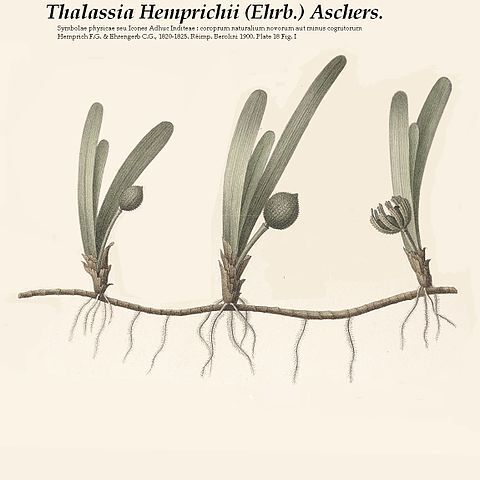Dioecious, glabrous. Rhizome creeping, terete, consisting of solid parenchymatic tissue with fine longitudinal air-channels; youngest part covered with membranous scales, leaving annular scars. Roots short, not ramified, densely set with fine hairs. Leaves 2-6, distichous, close together within a transparent sheath, linear, often somewhat falcate, in sicco slightly undulate, with very fine longitudinal air-channels, visible as a very fine parallel striation; parallel with these many short brown dashes; margin entiie; base pale; apex rounded, very fine-serrulate; nerves 9-15, parallel, near the apex joining the intramarginal nerves, mutually connected by square cross-veins. Ligule absent. Inflorescences peduncled, on the male plants 1-3, on the female plants 1, all 1-flowered. Spathal segments of the ♂ plants only on one side connate, those of the 9 plants on both sides. ♂ Flowers on short pedicels, female flowers subsessile. Perianth segments 3, elliptic. Stamens 3-12, nearly sessile, light yellow, anthers oblong, erect, 2-4-celled, latrorsely dehiscent. Pollen grains sphaerical, yellow, embedded in a gelatinous mass which later becomes a sort of moniliform chain, germinating already before having reached the stigmas of the ♀ flower. Ovary softly echinate, 1-celled or imperfectly more-celled, with a rather long, partly persistent rostrum; styles 6-12. Fruit globose or elliptic, softly echinate, beaked, the fleshy pericarp bursting with a number of stellately spreading valves. Seeds few, conical with a thickened basal portion, the conus corresponding with the cotyledon, the broadened base with the radicle (Fig. 14f); testa thin, fugacious; albumen 0.
Dioecious, submerged, marine, perennial herbs. Stem elongate, rhizomatous or shortly erect, the latter produced at regular intervals from nodes along the rhizome. Roots 1 per node where erect stems produced from the rhizome, simple, sand-binding, covered with fine hairs. Leaves sessile, usually 2–6, distichously arranged on the erect stems, linear, somewhat falcate, rounded or obtuse, distinctly sheathing at the base, opaque or somewhat translucent, with up to 19 longitudinal veins and numerous fine, longitudinal air channels, the longitudinal veins connected by cross-veins; margins green, entire. Stipules 0. Nodal scales 0. Flowers unisexual. Male spathes 1–2 in the leaf-axil, pedunculate, 1-flowered, composed of 2 bracts connate on one side only, the bracts oblong to lanceolate, acute to obtuse, entire or serrulate, translucent. Male flowers shortly pedicellate, remaining attached to the plant; tepals 3, elliptic, cucullate, strongly recurved at anthesis; stamens 3–12; anthers nearly sessile, oblong, erect, 2–4-thecous, latrorsely dehiscent. Female spathe solitary in the leaf-axil, pedunculate, 1-flowered, composed of 2 connate bracts, cylindric, but tapering at both ends, translucent, 2-lobed at the apex, the lobes acute to obtuse. Female flowers almost sessile; tepals 3, similar to the those of ♂; staminodes 0; ovary of 6–8 carpels, conical, muricate, 1(–3)-locular, placentation parietal; ovules several; perianth-tube narrowly cylindric; styles 6–8; stigmas 6–8, deeply 2-lobed, filiform, papillose. Fruit globose, beaked, densely hairy, opening by stellate dehiscence of the carpels. Seeds conical with a thickened basal portion.
Marine, dioecious, perennial herbs; rhizomes monopodially branched, with 1 membranous scale at each node, 1 unbranched root and 1 erect, short, lateral shoot at irregular rhizome node intervals. Lateral shoot with leaf scars when old leaves shed; decaying old sheaths persistent, forming a mass. Leaves distichously arranged, tufted, 2–6, differentiated into sheath and blade; ligules absent; blade strap-shaped, finely serrulate at apex, otherwise entire, glabrous, with 9–17 longitudinal veins; tannin cells numerous; stomata absent. Inflorescence pedunculate, 1-flowered, subtended by 2 connate spathes. Male flowers shortly pedicellate; tepals 3, elliptic; stamens 3–12, sessile; anthers subsessile, oblong; locules 2–4, dehiscing longitudinally; pollen grains spherical to globose forming moniliform chains. Female flowers subsessile; hypanthium partly persistent; ovary unilocular to trilocular; styles 6–8, each with 2 filiform stigmas. Fruits globose, warted, beaked; pericarp fleshy, splitting into irregular valves. Seeds few, conical; testa membranous.
Plants perennial, of marine waters. Rhizomes present; leaf-bearing branches arising from rhizomes at distances of several internodes; stolons absent. Erect stems rooted in substrate, unbranched, short. Leaves 2--6, basal, submersed, sessile; blade linear, base tapering to stem; apex obtuse; midvein without lacunae along side(s), blade uniform in color throughout; abaxial surfacely without prickles; intravaginal scales entire. Inflorescences 1-flowered to cymose, pedunculate; spathes not winged. Flowers unisexual, staminate and pistillate on different plants, submersed, short-pedicellate to nearly sessile; petals absent. Staminate flowers: filaments distinct; anthers linear; pollen embedded in gelatinous matrix, in moniliform chains. Pistillate flowers: ovary 1-locular; styles 6--8, not 2-fid. Fruits spheric, echinate, dehiscing into 6--8 irregular valves. Seeds pyriform; seed coat ephemeral.
Herbs, submerged marine. Rhizome elongated, creeping, with scales and extended internodes, giving rise to erect, short, leafy shoots. Leaves usually 2-6, distichous, ribbonlike or slightly falcate, veins 9-15, parallel, connected by cross veins, sheathed at base. Inflorescences pedunculate, 1-flowered; spathes 2, fused. Plants dioecious; flowers unisexual. Male flowers pedicellate; perianth segments 3; stamens 3-12; anthers subsessile, 2-4-thecous, latrorsely dehiscent; pollen grains spherical, stuck together into moniliform chains; female flowers subsessile; ovary 1-loculed; styles 6, each with 2 filiform stigmas. Fruit spherical or elliptic, split open at top by stellate dehiscence of fleshy pericarp into a number of irregular valves. Seeds numerous.
Rhizome at most 0.5 cm thick, with thin roots. Internodes longitudinally grooved and with a scale at each node. Leaf bearing shoots arising from the rhizome at distances of several internodes. Leaves 4-11 mm wide, with 10-17 nerves. Leaf tip obtuse. Dioecious. Male and female spathe containing 1 flower. Flowers with 3 tepals only. Stamens 3-12, subsessile. Ovary with 6 bifid styles. Fruit shortly stalked, globose, echinate, stellately dehiscent

